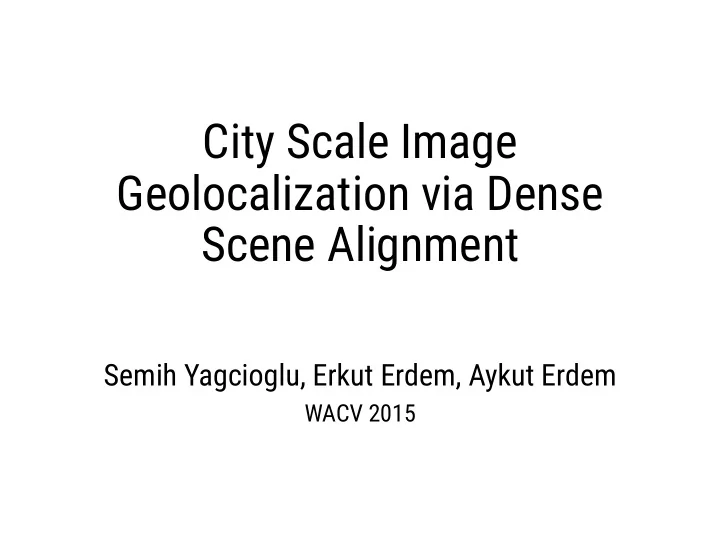

City Scale Image Geolocalization via Dense Scene Alignment Semih Yagcioglu, Erkut Erdem, Aykut Erdem WACV 2015
Hacettepe University
Computer Vision Lab
Our Aim • Predict geolocation information for a query scene • In a city-scale setting
Contributions • A coarse-to-fine strategy for the city-scale geolocation problem scales up well for very large datasets.
Scene Matching • Query scene and a set of matched scenes with geo- tags
Dataset • 1.06M perspective images • From downtown San Francisco
Query Set • 596 challenging query images taken by mobile phones
Dataset Locations
System Overview
Scene Retrieval • Retrieve visually similar images to the query image. • Retrieve initial set by GIST and Tiny Image similarity. • Key component of our method. • Final prediction accuracy depends on the quality of the initial retrieval set. • Short list size: 100, but might be utilized by dataset size.
Scene Alignment • Refine the initial set of images by densely aligning them with the query image. • Remove the remaining outliers with the worst alignment scores.
Outlier Removal • Eliminate non-likely candidates based on similarity and 2D distance via FNR algorithm.
Geolocation Prediction • Predict the most likely geolocation based on the candidate locations.
Experimental Results • We used a reference dataset of 1.06 million perspective images. • We evaluated performance of the proposed method via 596 challenging query images taken by various mobile phones. • We implemented the proposed method and algorithms in MATLAB and performed our experiments on a Linux based Intel(R) Xeon(R) 2.50GHz computer on 12 cores.
Evaluation Criteria • We evaluate the effectiveness of our approach in terms of three different criteria, that is accuracy, efficiency and chance. • The accuracy is computed by means of the estimation error, the distance between true geolocation of the query image and the predicted one. We consider a geolocalization successful if it is within 300 m. in the vicinity of its true location. • We analyze the performance of our method in terms of running times. • We compare our results against the random selection of a geolocation from the data set that we refer to as chance.
Qualitative Results • Query images (left) and retrieved images (right)
Quantitative Results • 24% of query set is geolocalized within 300 m. • 11 times better than chance. • All instances of query set geolocalized within 3.9 km. • Our suggested scheme (GIST + TINY + DSP) outperforms other schemes in recall rates for 300 m. threshold. • Runtime, 160 sec. on average (cf. SIFT-based baseline 135 sec.)
Quantitative Results • Gelocalization results for various schemes within 300m.
Conclusions • Our method combines global image descriptors with a dense scene alignment strategy. • Proposed method successfully geolocalizes challenging query scenes taken in urban areas. • As the dataset size increases, the overall quality increases.
Recommend
More recommend